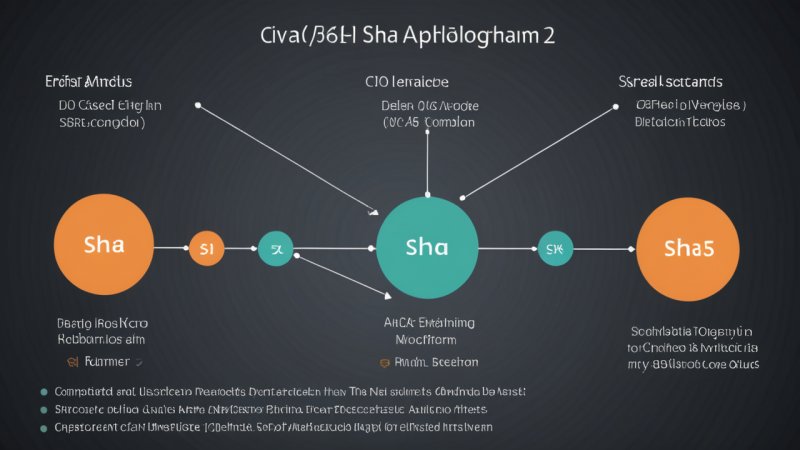In the realm of cybersecurity and data integrity, cryptographic hashing algorithms are fundamental tools that ensure the security of data through unique representations. Among the myriad of hashing algorithms available, SHA-256 and SHA-3 stand out due to their widespread adoption and robust security features. This article delves into a detailed comparison between these two hashing algorithms, highlighting their characteristics, advantages, disadvantages, and applications.
Understanding Cryptographic Hashing
Before diving into the comparison, it’s essential to grasp what a cryptographic hashing algorithm is. A cryptographic hash function takes an input (or 'message') and returns a fixed-size string of bytes. The output is typically a 'digest' that uniquely represents the input data. The primary properties of a good cryptographic hash function are:
- Deterministic: The same input will always produce the same output.
- Fast computation: It should be quick to compute the hash for any given data.
- Pre-image resistance: It should be infeasible to reconstruct the input data from its hash.
- Small changes, big differences: A small change in the input should produce a significantly different hash.
- Collision resistance: It should be difficult to find two different inputs that produce the same hash.
Overview of SHA-256
SHA-256 (Secure Hash Algorithm 256-bit) is part of the SHA-2 family, developed by the National Security Agency (NSA) in the United States. It produces a 256-bit long hash value and is widely used in various applications, including blockchain technology (most notably Bitcoin), data integrity verification, and digital signatures.
Pros of SHA-256
- Security: SHA-256 is considered highly secure, with no known practical attacks against it.
- Adoption: As one of the most widely used hashing algorithms, it enjoys extensive support in various software and hardware applications.
- Standardization: Being a NIST standard, SHA-256 is recognized and trusted in governmental and commercial sectors.
Cons of SHA-256
- Performance: SHA-256 can be slower compared to some other algorithms, especially for applications requiring high-speed hashing.
- Size: The 256-bit output may be larger than necessary for certain applications, leading to inefficiencies in storage and processing.
Overview of SHA-3
SHA-3, finalized in 2015 as a successor to SHA-2, employs a different underlying structure known as the Keccak algorithm. Unlike SHA-2, SHA-3 is based on a sponge construction, which allows it to produce variable-length outputs, making it versatile for different applications.
Pros of SHA-3
- Flexibility: SHA-3 can produce hash values of arbitrary lengths, making it adaptable for various use cases.
- Performance: SHA-3 is optimized for speed in software implementations and can outperform SHA-256 in certain scenarios.
- Resistance to different attacks: Its unique design offers a different set of security guarantees, making it resistant to attacks that may threaten SHA-2.
Cons of SHA-3
- Adoption: SHA-3 is relatively new; thus, it has not been adopted as widely as SHA-256.
- Complexity: The new design and implementation can be more challenging for developers unfamiliar with its structure.
Comparison of SHA-256 and SHA-3
Security
Both SHA-256 and SHA-3 provide robust security features. SHA-256 has stood the test of time, with no known vulnerabilities, while SHA-3, being newer, introduces a different hashing mechanism that may offer stronger resistance against certain types of attacks. However, both algorithms are considered secure and suitable for most applications.
Performance
In terms of performance, SHA-3 often outperforms SHA-256 in software implementations, particularly on modern architectures. However, SHA-256 is still exceptionally fast and efficient for most applications, especially those that have already optimized their systems around it.
Output Size
SHA-256 produces a fixed 256-bit output, which is sufficient for most use cases, while SHA-3 allows for variable output sizes, enabling flexibility for specific applications that may require shorter or longer hashes.
Adoption and Support
SHA-256 has been the industry standard for years, especially in blockchain technology and digital signatures. On the other hand, SHA-3, while recognized and standardized, has not yet seen widespread adoption, which may lead to challenges in compatibility with existing systems.
Use Cases in Cybersecurity
In cybersecurity, both algorithms find extensive use. SHA-256 is predominantly used in blockchain technologies, such as Bitcoin, ensuring data integrity and security in transactions. SHA-3, due to its flexibility, is finding applications in newer cryptographic systems, including secure communications and digital signatures.
Conclusion
In conclusion, both SHA-256 and SHA-3 offer unique advantages and disadvantages. SHA-256 is well-established, widely used, and trusted, making it suitable for environments where compatibility and standardization are crucial. SHA-3, while newer and less widely adopted, presents innovative features and performance benefits that may be advantageous in specific applications. Organizations should carefully evaluate their requirements and consider the potential of both algorithms when designing secure systems.






